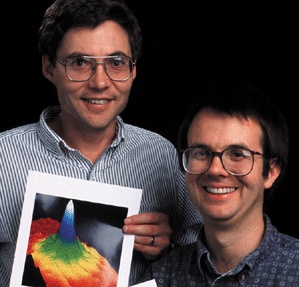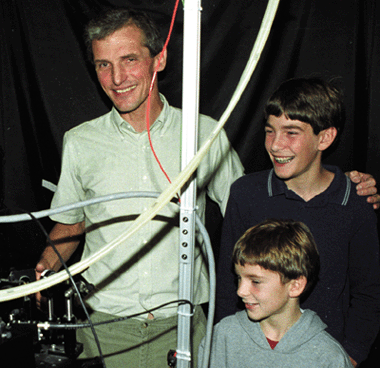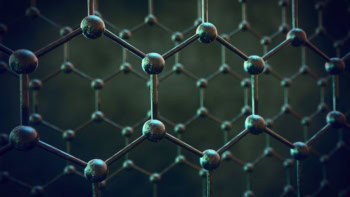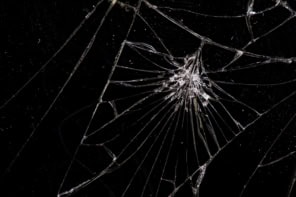The creation of the first Bose-Einstein condensate in a gas has been rewarded with the Nobel Prize for Physics just six years after the breakthrough was made.

In 1924 the Indian physicist Satyendra Nath Bose sent a paper to Einstein in which he derived the Planck law for black-body radiation by treating the photons as a gas of identical particles. Einstein arranged for Bose’s paper to be translated into German and published. He also extended Bose’s calculations to particles with mass and showed that, at sufficiently low temperatures, they would all condense into the same quantum ground state. And for the next 70 years physicists struggled to make a Bose-Einstein condensate – which is sometimes called the fifth state of matter – in the laboratory.
Then, in 1990, Carl Wieman of the University of Colorado hired Eric Cornell to work on the problem at the JILA laboratory in Boulder, which is jointly operated by the university and the National Institute of Standards and Technology (NIST). Finally, at 10.54 a.m. on 5 June 1995, Cornell, Wieman and co-workers managed to achieve Bose-Einstein condensation (BEC) in a gas of ultracold rubidium atoms.
The discovery made headlines all over the world and launched a period of intense research into the creation and properties of this unique state of matter. Over 30 groups have since made condensates and new breakthroughs are reported every month.
In August 1995 Randall Hulet’s group at Rice University in Texas reported inconclusive evidence for a condensate in a gas of lithium atoms – which they confirmed a year later – and in September 1995 Wolfgang Ketterle and co-workers at the Massachusetts Institute of Technology created a condensate in sodium atoms. Last month the Swedish Academy of Sciences awarded the 2001 Nobel Prize for Physics to Cornell, Ketterle and Wieman – a relatively quick award by recent standards.
Bose-Einstein basics
In a Bose condensate the de Broglie wavelength of the atoms is comparable to the average interatomic spacing, which causes the atoms to condense into the same quantum ground state. All the atoms in the condensate are described by the same quantum wavefunction, and this gives it many unusual properties (see “Bose-Einstein condensation” by Christopher Townsend, Wolfgang Ketterle and Sandro Stringari in Physics World March 1997 pp29-34).
Since the initial breakthroughs, Bose condensates have been used to produce atom lasers – laser-like beams in which photons are replaced by atoms – and to study fundamental physical processes. “BEC is now branching out into different directions, including atom optics and many-body physics such as superfluidity,” says Ketterle.
Atoms can either be bosons or fermions – the latter are particles that obey the exclusion principle and cannot therefore gather in the same quantum state – depending on their intrinsic angular momentum or “spin”. The fundamental constituents of matter – quarks and electrons – are all fermions, but atoms are bosons if they contain an even number of quarks and electrons.
The challenge when producing a Bose condensate is to cool a gas such that the average distance between the atoms becomes very small without the atoms forming molecules or the gas changing into a liquid. The Boulder team managed to achieve this in rubidium-87 by first cooling the gas with lasers – using techniques that were rewarded by the 1997 Nobel prize – and then using “evaporative” cooling in a magnetic trap. Their original condensate consisted of 2000 atoms cooled to 20 nK. The first MIT condensate contained 500 000 sodium atoms, and in late 1996 Ketterle and colleagues observed interference between two expanding condensates – clear evidence that all the atoms can be described by the same wavefunction.
While the Boulder and MIT groups led the way in exploring the properties of condensates, other groups achieved BEC with hydrogen, helium-4, rubidium-85 and potassium-41. In 1999 another group in Boulder, led by Deborah Jin, observed “quantum degeneracy” – the fermionic equivalent of Bose condensation – in a gas of potassium-40 atoms.
Reactions and applications
“The prize has certainly gone to the correct people,” says Mark Edwards, who runs the BEC Homepage at Georgia Southern University. “Eric Cornell and Carl Wieman’s original experiment will probably go down in history as one of the classic experiments of the 20th century. Wolfgang Ketterle deserves the prize because he and his co-workers, more than any other group, have performed experiments that have explicated the properties of condensates.”
Cornell, Ketterle and Wieman are the “correct choice” agrees Keith Burnett of Oxford University. “They worked with great determination, skill and courage to obtain the first condensates.”
So what is the ultimate Bose-Einstein experiment and what are the applications? “One great experiment would be a BEC atom interferometer on a chip, another one would be the study of BEC in lower dimensions,” says Ketterle. “Mid-term applications will be in precision metrology, and long-term they will be in nanotechnology. Speculative applications include quantum computers.”
Cornell, who is 39, received his PhD from MIT and is currently a senior scientist at NIST. Ketterle was born in Germany in 1957, received his PhD in Munich and is now professor of physics at MIT. Wieman, who was born in 1951, received his PhD at Stanford and is professor of physics at Colorado. The prize is worth 10 million Swedish kroner – about £730 000 – and the three will receive their Nobel medals in Stockholm on 10 December.
Physics World and PhysicsWeb have published many articles on Bose-Einstein condensation. See:
Bose-Einstein condensation Physics World March 1997 p29-34
Highlights of the year: 1997 PhysicsWeb December 1997
Amplification of matter waves PhysicsWeb February 1998
Highlights of the year: 1998 PhysicsWeb December 1998
Hydrogen: a quantum gas at last Physics World February 1999 p22
Putting the quantum brakes on light PhysicsWeb February 1999
Matter makes waves PhysicsWeb March 1999
Quantum entanglement spreads to Bose condensates PhysicsWeb June 2000
Atom lasers Physics World August 1999 pp31-35
Fermions go degenerate PhysicsWeb September 1999
Condensates in a whirl PhysicsWeb October 1999
Highlights of the year: 1999 PhysicsWeb December 1999
Molecules made in a Bose-Einstein condensate PhysicsWeb February 2000
Bose-Einstein condensation bursts out PhysicsWeb July 2001
Triple first for Bose condensates Physics World May 2001 p21
Condensate control could lead to ‘atom circuits’ PhysicsWeb October 2001
Condensates create Josephson arrays PhysicsWeb August 2001
Taming light with cold atoms Physics World September 2001 pp35-40
Condensates reap Nobel reward Physics World November 2001 p5
Summaries of the following Physics World articles appear on PhysicsWeb
Ultracold fermion race is on Physics World August 1999 p19
Bose condensates make quantum leaps and bounds Physics World August 1999 pp37-42
Quantum fluids create a stir in the lab Physics World January 2000 pp20-21
Amplifier means gains for atom optics Physics World March 2000 p24
Chaos gives quantum tunnelling a hand Physics World September 2001 pp24-25
The following articles appear in the print version only of Physics World
Magnetic traps hit a new low Physics World July 1995 p21
Atoms lose their identity Physics World August 1995 p21
Bose breakthrough Physics World December 1995 p8
Flipping the switch on an atom laser? Physics World October 1996 p18
Hydrogen condensate is go Physics World August 1998 p5
Condensation in a spin Physics World March 1999 p5
A double first close to absolute zero Physics World April 2001 p3
Condensates made easy Physics World August 2001 p3




